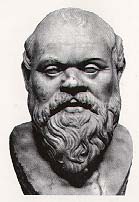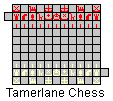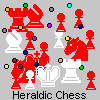 Here is what has worked for me when introducing anemia. Of course there are a lot of ways to do Socratic
teaching.
Here is what has worked for me when introducing anemia. Of course there are a lot of ways to do Socratic
teaching.
Can it be, Ischomachus, that asking questions is teaching? I am just beginning to see what is behind all your questions. You lead me on by means of things I know, point to things that resemble them, and persuade me that I know things that I thought I had no knowledge of.
-- Socrates
Quoted in Xenophon's "Economics"
Our medical school
is implementing a "topics"
curriculum for the first two years. This approach lends itself superbly to Socratic teaching.
The first pathology-focused "presentation" is anemia-pallor-fatigue (essentially, anemia).
 Here is what has worked for me when introducing anemia. Of course there are a lot of ways to do Socratic
teaching.
Here is what has worked for me when introducing anemia. Of course there are a lot of ways to do Socratic
teaching.
This works best in small groups, but almost as well in a big lecture.
* * *
Start with an empty blackboard. Stand in front of it. Smile. Say, "Anemia. It means you don't have enough red
blood cells on board." Pause. Smile. Say, "Why is that bad?"
Elicit answers according to your own style and preferences. ("Friendly interviewer" / "Random names" / "Drill
sarge" / "TA's strolling around with microphones" / others.) Reward all but the worst contributions. Repeat (into the
microphone) what each person has said (unless the contribution is very poor, in which case you ignore it; if a contribution
is good but with only a minor error, repeat it without or correcting the minor error). Ask narrowing questions. When the
point is clear, go back to broadcast, "Why else is not having enough red cells on board bad for you?" Use your
signposting skills. When you are done, say, "Can anybody think of any other reasons?" You'll have the big ones in about
60 seconds; you might add "And being pale makes you look unhealthy."
Back in front of the blackboard. Pause. Smile. "Okay. We've talked about why anemia is bad." (If you are
doing your job well, you have also gotten from them what physical findings will suggest anemia.) "Now let's think of some
reasons that a person might be anemic."
Smile. Pause. You have a greater tolerance for silence than they do. Somebody will contribute.
Repeat the contribution into the microphone. Smile. Ask focusing questions to try to make clear exactly what's being said.
When the contribution is focused, no matter whether it is broad ("He cannot make red cells") or narrow
("Something is wrong with his ferrochelatase enzyme so he can't put iron into the porphyrin ring"), write it on the
blackboard. While you are doing this, share a bit of knowledge. If Bill said, "Suppose you cannot make enough globin
chains", you write "Cannot make globin chains", you say, "There's a name for that. It's called 'thalassemia'" (or "Does
anybody know the name for that?"), and you write " = thalassemia" right after.
In preparing the exercise, you have already decided exactly where you are going to write it. This is where the
concept maps from Calgary can come in handy (for starters, though if this exercise is properly done, the results will be
much more detailed.)
It's natural here to ask, "Okay, why might a person be unable to make sufficient globin chain?" Or you might turn
to the class, put your pointer directly under the word "thalassemia", smile, and nod. Either is likely to get you an answer
that'll keep the group on track. If somebody says, "No ribosomes left in the body", you can say, "Right-o. But you'd be
dead before you became anemic." More likely, somebody will think of the genetic problem. Remind people nicely that
genes have regulators that tell how much of a protein gets made, and tie this to thalassemia.
If at this point somebody blurts out, "Antibodies against your red cells" before you have finished the "thal" unit,
you are in a no-lose situation. You can continue with the thalassemias after a thank-you to the new contrubitor and a
promise to go there next. ("This class is so smart.") Or you can say, "Good, we'll come back to thal when you've thought
what might cause it." Somebody will bring you back eventually.
When somebody blurts out an answer that's already on the board, thank the person and say, "It's worth
mentioning twice, since it's a very important clinical problem." Deal with an extremely poor contribution by ignoring it.
When other surprises come up, use your common sense and keep the experience as enjoyable for everybody as
possible.
Continue broadcast ("What else can make somebody anemic?") until things slow down. Then get more directive.
If they have not come up with the concept of thalassemia, narrow slightly. "What do you need to make a good red cell?"
Or perhaps, "Betty said we need DNA to make a good red cell. She was right. What else do we need?" Somebody will
say "hemoglobin". If they don't, get in somebody's face and say, "Do you need hemoglobin to make a good red cell?" If
they do not know what hemoglobin is, this is your chance to fill in this gap in their (grammar school) biology. Place,
"Can't make hemoglobin" in your spot. Smile. If no one mentions globin chains, say, "What do you need to make good
hemoglobin?" If no one can answer (or if we've already hit on "iron" and "porphyrin" and you are simply waiting for "globin
chains"), pick up a textbook (gasp!) and the class will get the hint. Somebody will answer.
Later you will fill your space for alpha and beta thal, along with the four-genes business for alpha-thal and the
various types and severities of each.
As you are completing your diagram, you may need to ask focused questions. ("How might I ruin my
ferrochelatase? I'll give you a hint -- what's a metal atom that the body might mistake for iron? You already know it's
poison.") You may or may not get the answer ("lead"); if you are doing a good job and you tell them ("Lead!"), you'll hear a
sort of ohh sound from the front row.
When this phase of your map is complete, stand in front of the blackboard, and smile. The students probably
think the fun is over. Hardly. You say, "Okay. What would a red cell end up looking like in...." (point to something). Soon
you will have sketches of each of the common abnormal reds. (Your sketches, or maybe a joyful
learner's.) You'll probably
have to tell them about delayed DNA synthesis causing prolongation of the segmenting process for neutrophils, but a
sketch of a ten-lobed poly will also grace your board.
Front of the board, smile. You say, "Okay. Let me tell you the names of some lab tests and what they show. Tell
me how each anemia would affect them." For more advanced learners, "Who knows some common blood labs?"
Expected results of reticulocyte counts, bilirubins, electrophoretic studies, iron studies, and (the centerpiece) MCV's. At
the end, you'll challenge them with the arcane stuff: "Okay, YOU think of an easy way to diagnose paroxysmal nocturnal
hemoglobinuria!" They might or might not be able to come up with the principle of the Ham test.
Depending on the topic, your last sequence might be, "How might you treat..."
When you are done, you can show your pictures, go over your handout, and so forth. Or several lectures by
various disciplines can follow in the coming hours or days, as can other kinds of active-learning sessions and patient
experiences. When you show your smear of iron-deficiency anemia, you'll say, "Remember the pale little red cell that Betty
drew? Here it is again." Another lecturer might say, "Remember how what's-his-name pantomimed ferrochelatase?" It
is impossible NOT to make things relate to each other.
Introducing "anemias" this way takes me about 40 minutes. I did a booth at the AAMC convention in the 1980's
on how I organized my "sudden-death" show, which is the longest I can imagine (keeps them entertained for 50 minutes).
It seems to me that every Calgary topic lends itself nicely to a show like this, early-on in the "system".
"Hypernatremia" is a five-minute topic. I do "high blood pressure" in about 30 minutes, and I think this would be average
for a Calgary topic.
ADVANTAGES
1. It's extremely active, and extremely meaningful. Students will walk out feeling good.
2. It provides clinical focus very early in the students' education, without forcing them to memorize anything.
3. By its nature, the exercise must, without fail, bring together anatomy, physiology, biochemistry, and pathology.
However, only a bit of knowledge of each is required to make the exercise a success, and gaps in the knowledge
get filled automatically.
4. Adult learners prefer this to rote memorizing, and rightly so.
5. Your learners judge you, the teacher, primarily by the interactive portions of your lectures. This is your chance to
shine.
0. You cannot use Power Point.
00. It drives "Notepool" crazy.
DISADVANTAGES
0. You cannot use Power Point.
00. It drives "Notepool" crazy.
1. You must have a knowledgeable faculty. We do.
2. You need a real blackboard or a very good substitute.
3. As teacher, you must have basic classroom skills, i.e., you know how to get the students to talk, you ask open-ended questions and know how to vary their level as appropriate, you have a reputation for firmness and fairness,
and you can keep this from turning into a p*mp session. This won't be a problem here.
4. Students will complain "Where do the test questions come from?" My advice is not to attempt to draw exam
questions directly from this exercise, but to take 5% off the course grade of any student called at random with an
unexcused absence
* * *
Other medical schools will, I expect, soon profit from our upcoming success with "topics". And they'll be jealous of how much fun we are all having with this approach.
Classroom Control
Good Lectures
Small Groups
The Effective Pathology Tutor
Preventing "F"'s
Dr. Koop's
Area (link is now down) --
"The issue is still being debated among researchers on what goes on
when a skilled clinician diagnoses a patient. We know this skill has little
to do with rote memory of facts."
| New visitors to www.pathguy.com reset Jan. 30, 2005: |
Try one of Ed's chess-with-a-difference java applets!
 |
 |
 |
 |
 |
 |
 |
 |
 |
 |
 |
 |
 |
 |
 |
 |
 |
 |
 |
 |
 |
 |
 |
 |
 |